When is Mobility cheaper than owning a car?
| Updated: |(Disclosure: Some of the links below may be affiliate links)
I have talked about car costs a few times already on this blog. However, I have never written about Mobility.
Mobility is a Swiss car-sharing cooperative. Mobility has a large fleet of cars in Switzerland. Mobility users can then use these cars when needed and do not need to own a car.
Is Mobility cheaper than owning your car? We must find out!
Mobility carsharing
Mobility carsharing is a cooperative with more than 3000 cars in Switzerland. The principle is straightforward:
- you reserve a car
- you get a vehicle at one of their dedicated parking spots
- you drive wherever you want
- you fill the fuel tank (using the Mobility card)
- you deposit the vehicle in one of their dedicated parking spots (not necessarily the one you started from)
With that, you can almost always have a car available, but you do not need to own a car yourself. You do not need to pay for insurance, parking, or maintenance.
In most cases, you will drive the car back to where you started. So, you will pick up a car, drive it somewhere, park it while you do something, and then finally drive it back to the parking spot. In some places, there are options so that you can drive the car and then let the car in another place, but this is not common.
On the other hand, you have to reserve a car in advance, there may not be cars available, and you need to go to a parking spot with Mobility cars. The last disadvantage is that it is mainly reserved for the people living in cities.
Generally, it is known that Mobility is excellent for people that do not need a car all the time. So, if you use a vehicle occasionally, you may save money (and hassle) by using Mobility instead of owning your car.
But when is it exactly profitable?
Costs of Mobility
First, we need to check out the fees for Mobility.
There are two primary plans:
- Mobility EASY
- You do not pay any yearly fees
- You pay at least 3 CHF per hour
- You pay at least 0.65 CHF per kilometer
- You pay 2.50 CHF per trip
- Mobility PLUS
- You pay 129 CHF per year
- You pay at least 2 CHF per hour
- You pay at least 0.60 CHF per kilometer
If you use Mobility a lot, you should use the yearly plan. Otherwise, you should use the Click & Drive plan.
They also have different families of cars at Mobility. We will use the Budget and Eco options for our comparison. The Budget option costs 2 CHF per hour and 0.55 CHF per kilometer. And the Eco option costs 2.5 CHF per hour and 0.65 CHF per kilometer.
You do not have to pay for fuel with Mobility. Indeed, each car has a payment card for fuel. So, should you need fuel, you can use this card for free for the car’s fuel.
It is important to note that you have to pay for each hour you have the car, not only for the hours you drive. So, if you do a 10-minute drive to shop for 2 hours, you will pay for 2 hours and 20 minutes (two times 10 minutes) for the car.
They also have plans for students and student drivers (who learn to drive). And they have one plan where you can buy a share of Mobility and then not have to pay the yearly fees. However, we will not include these plans in our comparison to make it simpler and easier to compare annually.
I use 50 kilometers per hour average speed for all my tests for the number of hours driven. But I account for five times the duration. On average, people will not drive somewhere for one minute and then drive back. They are going somewhere to run an errand. And that errand takes time. Therefore, if you drive 20 minutes somewhere (round-trip), I will account for 100 minutes total duration of rent. Sometimes, it is much more, but sometimes less, depending on the trip. Five times is a good average for the simulation.
I also assume that each trip lasts 50 kilometers on average. So a 500km usage means ten trips. I use this information for the trip fee of the EASY plan.
Costs of owning a car
For my comparison, I will use the following parameters:
- Parking costs 100 CHF per month (in the city).
- Insurance costs 800 CHF per year for a cheap car and 1200 CHF per year for a medium.
- The cheap car does 5.5 liters per 100 kilometers, and the medium car does 6.5 liters.
- Maintenance will vary based on the kilometers, and the medium car is more expensive.
- A cheap car costs 15’000 CHF new and a medium car costs 25’000 CHF new
- We amortize both cars over ten years.
These numbers come from my (limited) experience with cars. I have had cars for more than ten years. I have always tried to limit my costs and never looked for powerful cars.
Of course, your mileage will vary. If you have an expensive garage, you will pay more maintenance costs. And depending on your canton, you may pay significantly more insurance.
But since this blog is for frugal people, I will also assume frugal ownership of a car.
Here, I am only considering buying a car in cash, but there are other ways to finance a car. And sometimes, buying a car in cash is not always the best solution.
Mobility vs owning a car
So, we will compare Mobility plans vs owning a car for different driving distances per year. I will display the yearly costs of each option.
First, we start with only 500 kilometers per year.
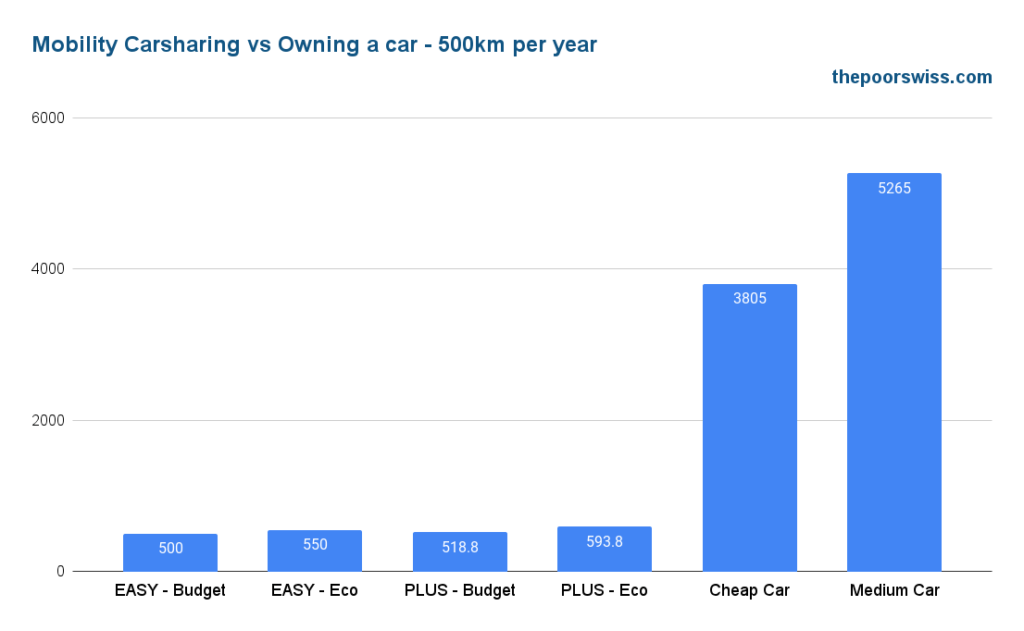
This graph shows that you should not own a car if you do not drive it! The base cost of a car is high even if you almost do not drive it. Parking, insurance, and amortization will be almost the same whether you drive it. In this case, using Mobility is much cheaper than owning your car.
We can also see that you can save a little money using the EASY option rather than the PLUS plan, but the difference is almost insignificant.
Then, we look at 1000 kilometers per year:
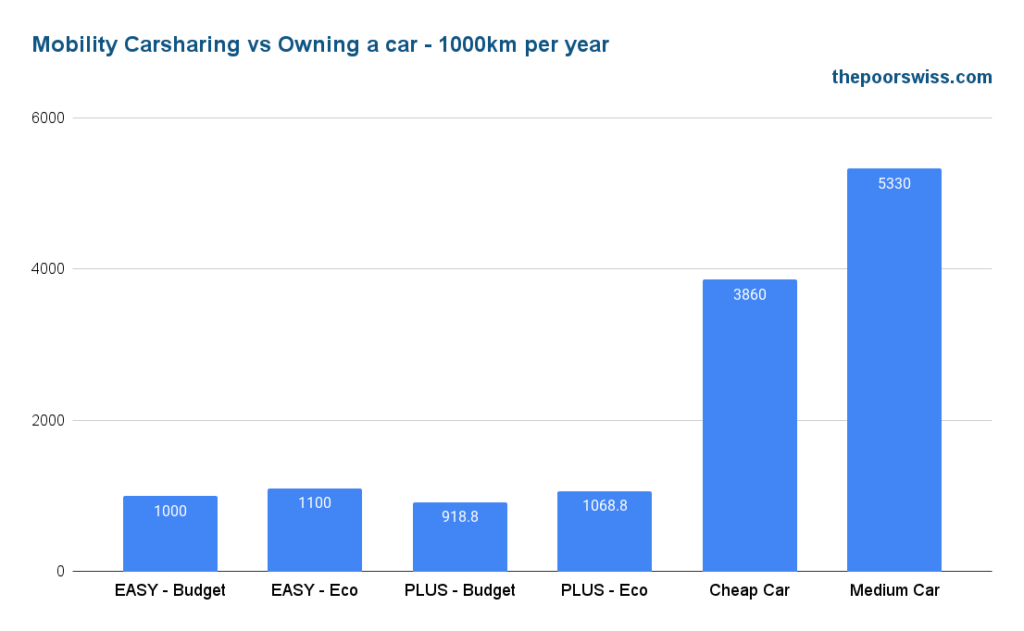
Once again, Mobility is much better, even though it has doubled in price. On the other hand, the PLUS plans have become more interesting than the EASY plan.
We then move directly to 2000 kilometers per year.
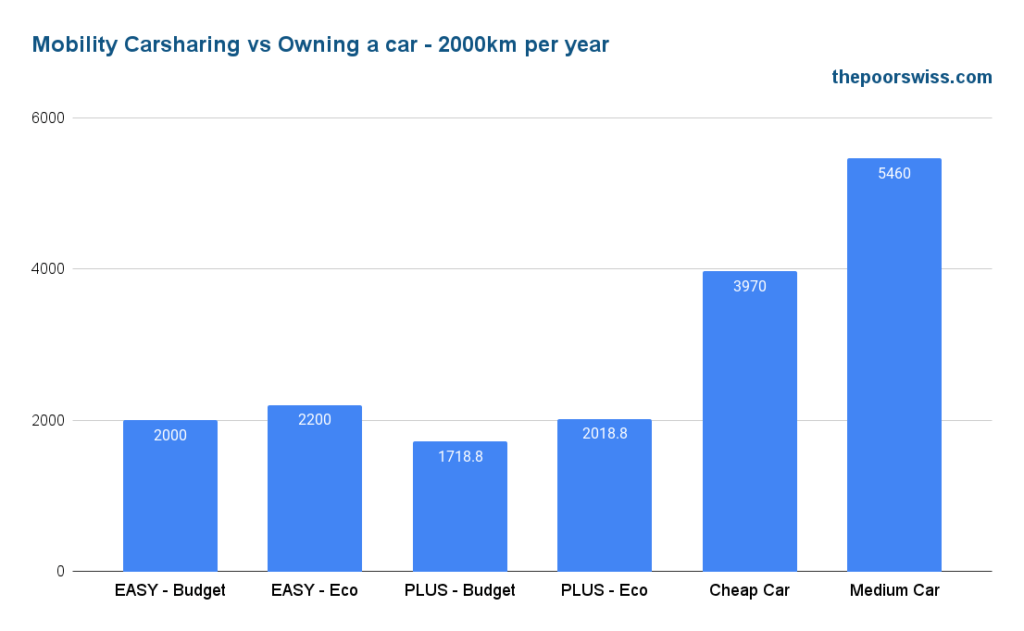
While Mobility is still significantly cheaper, we can see that the gaps have become smaller. But even at 2000 kilometers per year, Mobility is still very interesting!
We can jump to 5000 kilometers per year.
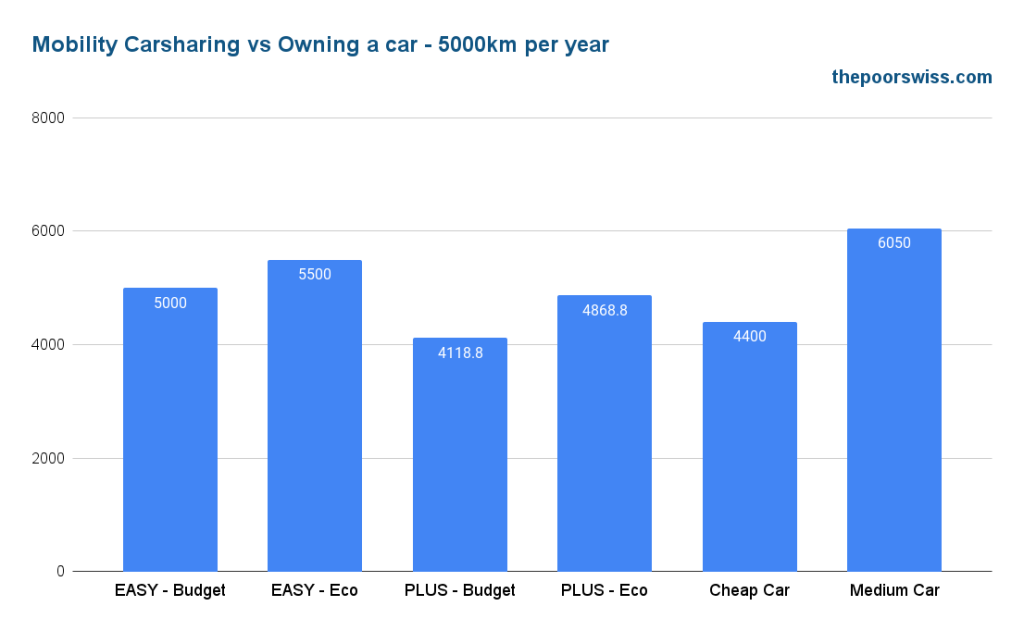
This time, the comparison becomes very interesting. At this point, the PLUS option of Mobility is only slightly cheaper than a cheap car, and the PLUS eco option is already more expensive.
It is also very interesting because this is where I am with my car these days. I could save very little money by switching to Mobility. I cannot even consider it because the next Mobility parking spot is 10 minutes away by car. But it is still interesting that with my driving needs, I should consider Mobility. I would think that the limit was lower.
On the other hand, I think that at 5000 kilometers per year, the convenience of having your own car outweighs the financial benefits of Mobility.
It is also interesting to note that the PLUS plan is significantly cheaper than EASY. Also, we can see more clearly the differences between the Budget and the Eco options.
Before we jumped to 10’000 kilometers, I checked where the threshold for Mobility was, and it was around 5450 kilometers per year for the parameters of our test. It means that below 5450 kilometers per year, Mobility (PLUS plan and budget car) is cheaper than owning a cheap car.
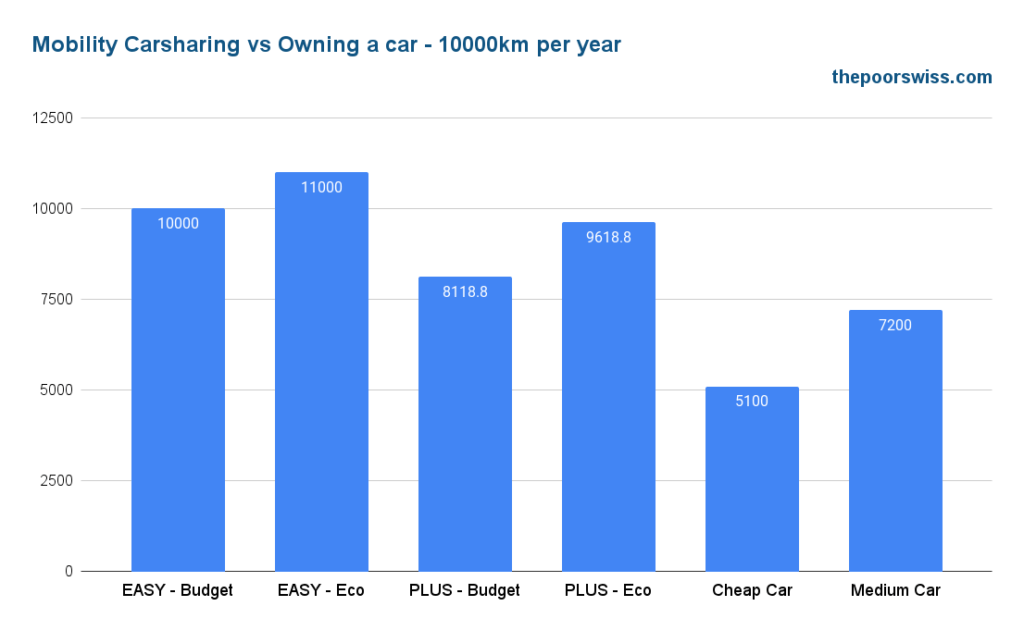
At 10’000 kilometers, owning a car becomes significantly cheaper than all the Mobility plans. Plus, at this number of kilometers, it is probably immensely more convenient. Since the average yearly mileage in Switzerland is about 13’500 kilometers, Mobility is not attractive for most people.
In that situation, even a medium car is cheaper than all the Mobility plans.
Here is what happens at 20’000 kilometers. For this example, I will assume amortization over only five years (100’000 kilometers).
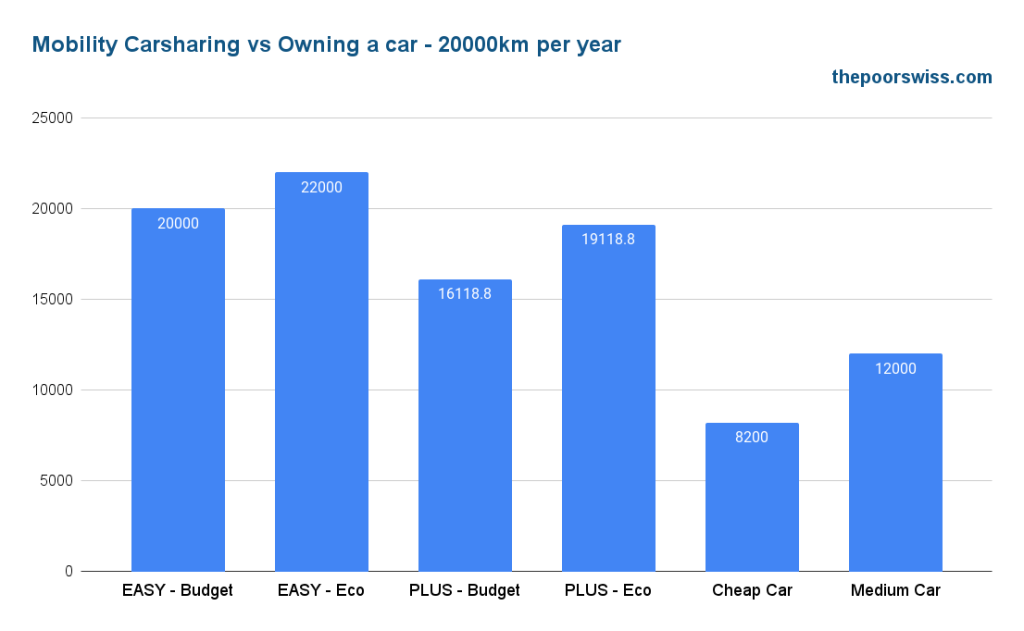
With this high driving number, the cheap car becomes significantly more affordable than Mobility. You could save 7000 CHF per year by owning your car.
Finally, here is what would happen with 50’000 kilometers (not sure anybody drives this much) with only two years of amortization.
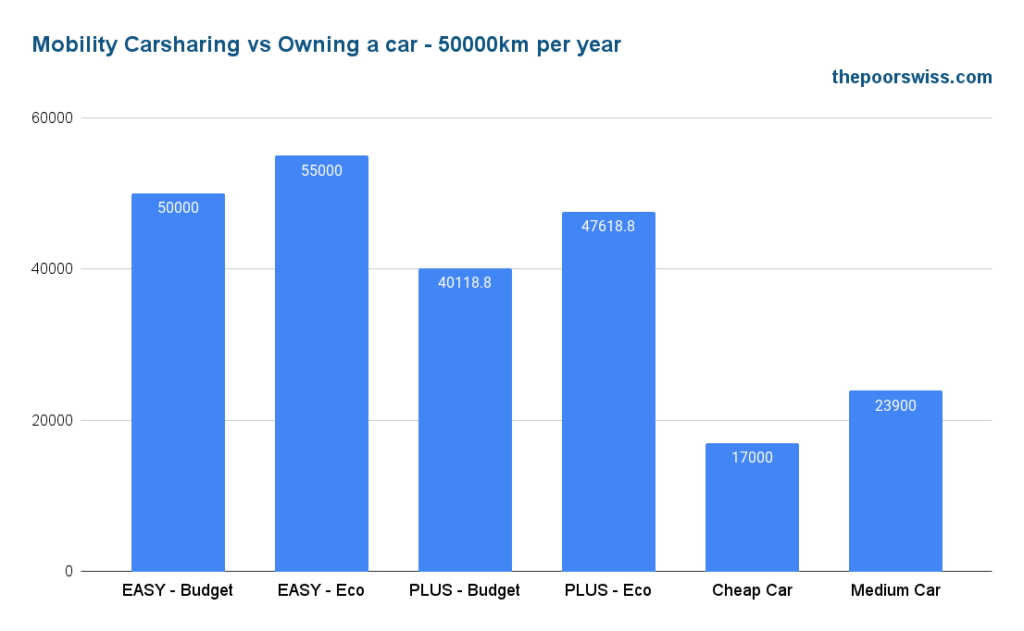
In this case, even a premium car would be cheaper than Mobility. But very few people (if any?) drive that much per year. At this point, owning a car is much cheaper than Mobility.
Conclusion
Overall, Mobility is an excellent alternative to owning your car if you do not drive too much. If you have access to a Mobility station and do not drive too much per year, you should consider it.
I was surprised by the results. With the amount of driving we do since I work from home, Mobility would become interesting. I was not expecting that.
I would still prefer the convenience of having my car since we use regularly for short drives. Nevertheless, it was an interesting result.
Indeed, there are advantages to owning your car if you need it in an emergency. But there are also advantages to Mobility, such as not having to deal with maintenance.
Talking about transportation, I have an article about how we get around in Switzerland. And if you are interested in cars, you should read my article about car insurance.
What about you? Have you ever tried Mobility?
Download this e-book and optimize your finances and save money by using the best financial services available in Switzerland!
Download The FREE e-bookRecommended reading
- More articles about Money-Saving Tips
- More articles about Save
- How to work out at home for free in 2024
- How To Save Money with a Vegetable Garden
- Frugal Living in Switzerland Interview 5: The DoubleDutch Family

The main issue of Mobility is : if you not live in a city, you can forget it…
Is there any service which prevent from this issue, it means “your car comes to your home” ?
Hi Kens
That’s correct, Mobility is pretty much useless in a village.
I don’t know any service that would help in that regard. You could take the bus to go the city and then take a car, but then you would likely be better off with a car or with only public transportation.
Hi, nice blog post. I was looking for alternative ways to travel in Switzerland. Like Train + Electric Scooter. Your post caught my attention. But I don’t quite understand the charts, I’m not great at math. So, in the first chart (500km per year), owning a Cheap Car has the value of 3805 CHF. Is that per year over 10 years? Like 3805CHF * 10 years = 38050CHF is the total amount it will cost me? Does the 3805CHF includes 15’000CHF of the car cost? I quite don’t understand how you add up to 3805CHF.
Thank you and best regards
Hi Uma,
Yes, everything is displayed per year. I am considering amortization of the entire cost over 10 years. So, for a cheap car, 1500 CHF per year is part of the 3805.
If you only drive 500 km per year, amortization could be much longer of course, but I tried to keep it simple.
Hi Baptiste,
Thanks for your article, the analyses are very interesting as usual.
However, it is likely that a Mobility user also has a general train subscription, while it is I think less the case with a car. Do you think this is a relevant parameter to take into account in the simulations?
Hi Martin,
I think assuming that a Mobility has a general train subscription is too much. We should not assume that Mobility is expensive because users are also likely to use public transportation.
This is a great analysis and very helpful. Indeed, I think Mobility/car sharing wouldn’t work for us, as we like to do weekend trips and often a car is just far superior than the train, since you are more flexible.
I am not sure whether you have an article on it already, but I am reading more and more about these Car Abos (e.g. Carvolution). At first glance, it seems a bit expensive even when all-inclusive, especially in Zurich, but I want to dig a bit deeper. Any thoughts?
Hi Jonathan,
Actually, since I hate driving, I prefer the train over cars. The problem with trains is that it’s just too goddam expensive in Switzerland, so we usually take our car anyway.
I had never heard of car abos :) At first glance, it looks like another bad version of leasing. But I will try to take a deeper look.
Hi Baptiste,
That’s a hot topic in CH so glad to see your article.
My 0.02$:
From my experience, and as another reader mentioned most of Mobility is of Return type. So idle time counts against the user. e.g. I used to use Mobility to go groceries in our neighboring country as I live right next to the border. Normally for a weekly grocery we had to count at least 3 hours and 20-30 km out of which less than one hour was actual driving (something like 40 minutes if no traffic). Most of the times we were returning the car half an hour early, but we wanted to allow for a bit of buffer time to avoid hefty penalties in case we were late.
In addition another thing to consider is the risk of damaging the Mobility car. Scratches can happen and I’m not sure how strict they are with claiming them from the last user. In general without the additional insurance the deductible is quite high (2500 while with the Mobility insurance is 300). I always used the first 10 minutes to take video of the car and call the center to report obvious damages and big scratches which were not logged in the app. I actually realized that they never really logged them, besides me reporting them several times that I used the same car of my neighborhood.
Of course one could claim that this applies to own car as well, but then you have the choice to repair it or not if it’s just a small bumper scratch for example.
Another factor to consider is time spent walking / cycling to the nearest car and time to plan and reserve the car, as well as the fact that Budget’s are not always available in bigger cities at the busy weekends. And of course the lack of flexibility with times (you need to move the booking x hours in advance for the change to be free and cancellation is almost never for free).
All in all I think Mobility has worked great for us, but we were using it for distances that we could also cover by bike (or e-bike) in many cases.
But with the baby arrival we thought that it’s time to get our own car, and I have to admit regardless of cost, at times it’s way more convenient (at other times it’s just a burden though.
Hi Sol,
Thanks a lot for sharing.
Interesting, I did not think about insurance. I was thinking that using Mobility, we would not have to think about that. I did not even know some defect were logged in the app, it’s good to report more of them.
But I hope they do not claim them back from the user, unless there is a big fault from the user.
That’s a good point. Unless you live right next door to a mobility station, you will have to first go there and then come back.
With a baby, I can’t even imagine having to go a Mobility station, install the baby seat and then having to remove it later, it’s just too much of a pain, convenience really wins.
The lack of baby/child seats is the main reason I don’t use mobility more. I’ve got two children and it’s annoying having to install and remove the seats all the time. For me, the way I want to use it is to take a train somewhere then hire a car when it’s not convenient to go somewhere by public transport. But can’t do this as there’s no child car seats (and I’m not taking two seats on the train with me).
I’ve just ended up not owning a car and only using mobility a bit. I like not owning a car as it helps you avoid shorter journeys that you’d do in a car that you could walk/cycle etc.
I completely understand. Having the need for car seats for children up to a high age makes it very difficult to not have a car. It already makes it more difficult to plan trips in our own car, but having to change cars and carry the baby seats is definitely a no-go for me too.
As always, good article with some interesting points.
For most people, that would have a more expensive car on a leasing (I know that’s not very frugal but that’s the reality), the threshold would be more between 8000 and 10’000 km/year, but it depends if you have a Mobility station close to where you live.
Mobility is also very good in the way you can change your car type depending on your needs : very small car for a quick trip or big van if you want to go to Ikea.
I would rather calculate the car amortization on 200’000km or 15 years. Car nowadays can handle 250’000km easily when well maintained.
I have actually a very good history with cars, driving almost 40’000 km/year… I sold my first car with 370’000km (9 years old) and my current as now 200’000km (6 years).
All where bought second hand and the cost per KM (accounting for really everything, with 600 CHF/year for non planned repairs, even taxes deduction…), my current German 200 HP wagon costs less than 0,33 CHF/km (Diesel is the most important cost 4.8k, then amortization 4.4k).
As always, you have to compute what is the best for your situation, but I’m convinced that 33% of people should use mobility.
Hi Torvi,
Thanks for sharing your experience and numbers!
I don’t have that good of an experience with you, that’s why amortization over 10 years makes more sense for me. But my experience is with cheap cars and I am only going through my second car now, so not that much experience. I also drive much less than you. Currently, it would take me 7 years to drive as much as you do in a year :)
If you count amortization over 200’000km, owning a car becomes even better.
If you add leasing on top of a car, Mobility becomes even better I believe.
Hi,
I found it clever the way how you graphed the costs by setting a fixed speed of 50km/h, however as someone else mentioned this assumption underestimates the mobility costs as you have to pay for the time the car is not being used. I had done some calculations a few years ago and for all my use cases I would have ended up with much lower km/h considering what you have to pay while the car is not in use. Here some example scenarios for my situation (I live 5 minutes walk to a mobility station):
1) supermarket shopping or other short trips
Time rent: 2 hours
Mileage: 6km
Speed: 3km/h
2) visiting family/friends who live away from the city
Time rent: 6 hours
Mileage: 80km
Speed: ~13km/h
3) weekend trip
Time rent: 60 hours
Mileage: 220km
Speed: ~4km/h
4) longer trip to Italy (probably conventional car rental is better here)
Time rent: 168 hours
Mileage: 400km
Speed: ~2km/h
For example, in my case, with a combination of above use cases I was planning to drive 4000km per year but that was costing me around 6000chf with click and drive Budget although I would prefer bigger cars for the longer trips. This is almost double than what you estimate in the 5000km graph. Of course all this will vary massively by use case, but for the sake of comparison I think this could work pretty well if you just lower the km/h assumption from 50 to 5 or maybe to 10 km/h which would be more realistic with the way how mobility can be used. In my case 10km/h average would work well as use case 2 is my most frequent one. I don’t find use case 1 worth it as at this point it would be cheaper to walk to the store and take a taxi on the way back. Now I anyway just bike to the store but would do this if I really need to buy something big that I can’t carry on the bike. I also find mobility very expensive for use cases 3 and 4, so I end up taking the train or normal rental. For me use case 2 makes the most sense but I find each trip still quite expensive with mobility (70chf) but the journey takes twice the time by public transportation and costs 13chf.
I hope this helps, would love to see your analysis taking the time cost of mobility into account as per above scenarios and others.
Thanks,
Hi Mikasa,
Thanks a lot for your scenarios and analysis!
I agree that multiplying the time for Mobility trips by 4 or 5 is indeed necessary for this analysis.
I am going to update the articles in the coming days/weeks with new results!
Mobility is great. I use it instead of having a car. However there is an element missing from your calculations. In most of the cities the most common option available in mobility is “Mobility Return”. That means that if I want to go somewhere for let’s say 4 hours, I need to pay for all these 4 hours. Even if it was only 10 km away and it took me 10 minutes to go there and other 10 minutes to go back, I still need to pay 8 hours flat fee for the time I’m going to use the car.
Hi nick,
Oh, that’s an excellent point. You can only save on that if you can park the car in a mobility spot and reserve another in your destination. Thefore, the duration can be much longer than the duration of the trip and make the trip more costly.
Thanks for pointing that out :)
Well, with “Mobility Return”, you can’t do that. You must always return it in the spot that you reserved. Mobility Go allows you to drop it anywhere and Mobility One-way in the mobility spots.
Mobility Go is only available in Basel and Mobility One-way usually between some train stations.
So for the example provided by Nick, I see no solution.
I live in the ZH kanton and I mostly see that Mobility offers Renault car brand here, which are on the cheap side of the market. So if we were to compare apples with apples, I’d compare the Mobility costs with the cost of owning a cheap car. Therefore, based on your analyses, I’d say if one drives more than 5000 km/year it is worth owning a car. Especially when Mobility coverage is not that good and when you have to worry if the car is available before your unplanned trip.
That’s a really good article and I much appreciate the effort you put into it. I’m a car owner and I always wanted to make this comparison but never had time to do it.
To return the favor and make my contribution to this article/community I’m gonna share the yearly costs I have with my premium car, a car produced in 2016 bought SH from Germany in 2017. When I bought the car it had 18k km on board and it cost me 32k Euro. Now after 5 years it has 75k km and most likely I would be able to sell it for 18k Euro.
Costs:
– free parking bcz I live outside the city
– 750 yearly insurance(Teilkasko)
– my yearly service invoice is around 800Euro (one year I just need to replace the tires which last time cost me 500E, on another year I have to replace the oil, filters, and braking pads which cost 1200Euro). The service is done at BMW Germany, bcz is much cheaper than in Switzerland.
– my average diesel consumption is 5.5 liters. With the current diesel prices that means a yearly cost of 1400Euro
Summing all together it results in a yearly cost of about 3000Euro(or CHF, because nowadays they are at parity)
Looking at your graph named “Mobility carsharing vs Owning a car – 10000 km per year” I see you either were too generous with the “Cheap car” costs or you included the car deprecation in that amount of 5100. If the second then I’d also need to add a cost of 2.8k/year(during the last 5 years my car value deprecated with about 14k Euro).
So 5800 chf would be my yearly cost of owning a premium car in Switzerland
Hi Alex,
Thanks for your kind words :)
Yes, at 5000 km per year, there is also the convenience advantage of having a car that sometimes is better than saving money, even at lower amounts of km per year.
Thanks a lot for sharing your numbers. It’s interesting that you can save a lot of money by servicing your car in Germany.
I definitely added deprecating (the value of the car divided by 10). In your case, I would actually use 3200 EUR per year in deprecation over 10 years or 14k over 5 years as current deprecation, as you said. So, this total would come to 5800 EUR indeed.
It looks like your math is indeed correct and similar to mine. I am guessing you are saving by the cheap services and by having free parking. Are you not paying a cantonal fee for the vehicles in ZH? In Fribourg, this would add something like 500-1000 CHF per year based on the car. I counted 1200 CHF per year for parking, which would put yourself in between cheap and medium, so I think you are doing great :)
If you use Mobility regularly, you should definitly become a member to save money. You deposit 1000.- (you get that back if you leave) and a inscription fee, but no more yearly fees.
There are 6 Mobility cars in our underground car park. I’m lucky :-)
Yes, the more often you use the more interesting it is to become a member.
Nice indeed!
Are you using them a lot?